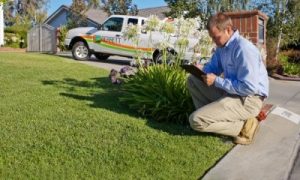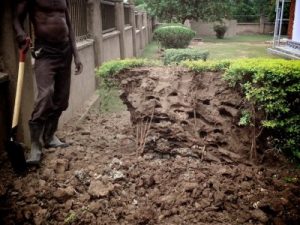
One problem – thousands of solutions. Termite infestation is exactly this kind of problem.
When you’re exploring all the treatments it’s hard to choose what do you need right now.
One of the ways to determine what you need is according to the time the protection will last, or how fast the colony will be exterminated.
Hide content
- Soil Chemical Treatment
- Physical Barrier
- Polymer Physical Barrier Impregnated With Termiticide
- Baiting Systems
- Wood Treatment
- Structural Tenting
- Sprays And Foams
- Useful articles
To make this kind of classification we need to divide the treatments in two groups:
Soil Chemical Treatment
- Type: preventive.
- Termite type: subterranean.
- How long does it last: 5-10 years depending on chemicals chosen.
Learn more about subterranean termites: signs of their activity; best methods of treatment and DIY methods. Eastern subterranean termites and their tunnels and tubes with photo.
Soil treatment can be used likewise before and after construction of the house. The idea is simple – you make an invisible line around your structure that repels termites, that are trying to enter our house from underground.
For this you need to dig a trench around the building or its foundation, pour the insecticide dilution into it and replace the soil, mixed with more insecticide.
It’s much easier to install a proper chemical barrier pre-construction, because after it the proper execution if the soil treatment might include such measures as soil replacement and drilling of the concrete slabs and surfaces.
Important! Usually, the use of the strongest chemicals for the soil treatment require a special license from the manufacturing company.Physical Barrier
- Type: preventive.
- Termite type: subterranean.
- How long does it last: up to 20 years.
Physical barriers have to be installed pre-construction. Basically, you add a layer of certain material, impenetrable for the termites, around the foundation of the house to prevent the termites from entering your house.
The materials can be different:
- sand or basalt particles;
- polymer;
- steel mesh.
The installation of those barriers is a complex process and should be trusted to professionals. Get an advice from the trustworthy pest operator if such a treatment makes sense in your area (the weather conditions or soil type can be unfavorable).
It’s rather expensive way of protection, but, if done properly, it’s a long-lasting environmentally responsible treatment.
Polymer Physical Barrier Impregnated With Termiticide
- Type: preventive.
- Termite type: subterranean.
- How long does it last: up to 50 years.
The way this barrier installed is the same as of the simple polymer physical barrier. The difference is that the material itself has a built in protection against termites. So it does not only stop the insects physically (that is effective until the barrier is even a little bit compromised), but also repels them and kills them, if they are bold enough to taste it.
The manufacturers of this pre-construction treatment are so sure in the protection their method guarantee, that they include a warranty that lasts up to 25 years. This way of protecting your house is not cheap, but it’s an investment once and for long time.Baiting Systems
- Type: preventive and fighting.
- Termite type: subterranean.
- How long does it last: 0-3 years.
- How much time it takes to exterminate termites: 3-6 weeks.
The baiting stakes can be used as both a preventive and active termite fighting method.
Anyway, the treatment starts with the installation of the stakes around area you wish to protect. For example, around the house foundation, with the distance of 1-2 feet between the stakes.
When you decide to use the baiting method, make sure you choose the stakes that allow you to monitor termite activity. Once you installed them, you will see if there’re termites visiting your building (if you don’t know it for sure already).
If there’ is no termite activity in any of the stakes, then they can stay for up to 3 years the way they are, and after this time you’ll need to change them for the fresh ones.
Not strictly a preventive treatment, the baiting stakes are more of a signal system, that tells you when you have a problem and simultaneously starts to solve it.
When you have an active infestation, the baiting system also can help enormously. Though not too fast – it has a way to destroy a subterranean termite colony, hidden somewhere in the soil. The termiticide inside the baits should have a delayed action for this matter.
This way, the foragers, that are eating the cellulose material inside the stake, have time to bring the poison back to the nest and share it. And, if it slowly doesn’t destroy the colony, it will at least reduce its numbers.
Here you can learn more information about termite bait systems: Advance, Green, CSIRO, Nemesis, Exterra, Firstline, Terminate. Also find out how to make baits by yourself and how to refill them?
Important! Do not forget to change the baits in due time or when they were eaten, otherwise the protection will wear off fast.Wood Treatment
- Type: preventive and fighting.
- Termite type: subterranean and drywood.
- How long does it last: life of wood.
- How much time it takes to exterminate termites: killing on the spot.
Learn more about drywood termites: signs of their activity; best methods of treatment: spot treatment and DIY methods; how to get rid of them in furniture?
Wood treatments can be different, from absolutely non-toxic eco-friendly solutions, such as orange or essential oils, to Spectracide and Termidor chemicals.
For the prevention of the infestation you should simply apply the termiticide to the wood with the mist spray or a paintbrush.
This will be a very good treatment to combine with the soil barrier for the subterranean termites.
You should apply termiticide to all the wooden construction elements coming in contact with soil, to prevent termites find an entry point, if they breached the chemical barrier.
If you’re fighting and active infestation, the wood treatment can also be efficient. Mostly, it comes at hand if you’re struggling to exterminate a local drywood infestation, for example, in piece of furniture. The difficulty of this treatment is to reach the termites that are hiding inside the timber.
For this you can inject the termiticide into the kick holes, made by termites themselves. Or you can drill the holes into the wood core, to be sure you reached the deepest corridors of the nest.
Important! Remember, that the treatment of the surface of the wood is often possible only for the untreated wood. The lacquer or paint won’t allow the termiticide to penetrate the structure of timber.Here you can learn more information about effective termite control remedies: Bora-Care, Boric acid, Borate, Fipronil, Chlorpyrifos, Chlordane, Borax, Timbor, Termidor, Terminator, Phantom, Lorsban, Biflex, Terro. You can choose different forms, such as – foam, liquid, powder.
Structural Tenting
- Type: fighting.
- Termite type: drywood.
- How much time it takes to exterminate termites: 72 hours.
Structural tenting is a fumigation method that is one of the most efficient in destroying all the drywood termite colonies, existing in the structure, at once and with a guarantee.
This treatment can only be performed by professionals, and, in short, it goes like this: the whole structure is being covered with a huge plastic tent, the gas is released underneath it, after 72 hours al the termites nesting anywhere inside the house are dead.
This treatment will take some preparation to do.
You have to find a place to stay with your family and pets for 2-3 days, remove all the plants from inside the house, and make sure there’ is no unsealed food left anywhere.
The operator monitors the gas concentration all the time and makes sure that it is safe for people to come back.
The gas used is often a sulfuryl fluoride, it leaves no residual whatsoever, so the fumigation will not protect your house from termites coming back. So, our recommendation is to combine this method with further preventive treatments.
Here you can learn more information about effective treatment method called tenting (fumigation): dangers for termites, preparing for fumigation and cleaning after, how long does this procedure last?
Sprays And Foams
- Type: fighting.
- Termite type: drywood and subterranean.
- How much time it takes to exterminate termites: kills on the spot.
Sprays are one of the least effective termite fighting methods. Yes, it will kill the insect you see immediately, but what good will it do you, if the whole colony is hiding somewhere inside your house or in the garden?Foam is much better way of reaching the termites that are hiding in the core of the timber. When you inject it through the termite holes or the holes you drilled yourself, it expands rapidly inside the wood, and penetrates all the hidden termite galleries.
For the small drywood infestation it can be a very good fighting method. And for the subterranean termites it can be a treatment to combine with the baiting system, to reach the nest as well as the foragers in your house.
Useful articles
If you interested in more information of termites we recommend you to read the following articles:
- All types of termites. Are they harmful to humans? Can they bite you? And what is the difference between drywood and subterranean ones?
- What does swarmers of different species look like: drywood, subterranean, formosan?
- Signs of infestation outside and in the house: in walls or furniture.
- How to treat them at home and in the yard: in fence. What is pre-construction treatment?
- What does termite holes look like? What is droppings and is it toxic to humans? Do termites make noises?
- Posible termite damage, how does it look like? Examples of damage in walls and wood floors.
- All about flying termites: how do they look like, swarming season and what to do if there are swarmers in your house?
- How do they do nests and mounds? How to find it in your garden or inside the house?
- Termite life cycle – from egg to larvae. And social hierarchy: workers, soldiers, queen.
- Did you know that termites can infest living trees, for example a palm or a pine tree. They also like to live in stumps.
- You can prevent the infestation by using barriers, such as: HomeGuard, Physical systems, Safeguard, Stainless steel mesh, Kordon.
- If you want to get rid of termites naturally, learn more about such methods as: heat or cold treatment, orange oil, using nematodes.


